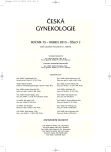Changes in the length of implanted mesh after reconstructive surgery of the anterior vaginal wall
Authors:
K. Švabík 1; A. Martan 1
; J. Mašata 1; R. El-Haddad 1; M. Pavlikova 2
Authors‘ workplace:
Gynekologicko-porodnická klinika VFN a 1. LF UK, Praha, přednosta prof. MUDr. A. Martan, DrSc.
1; EuroMISE Centrum, Ústav informatiky Akademie věd ČR v. v. i., vedoucí prof. RNDr. J. Zvárová, DrSc.
2
Published in:
Ceska Gynekol 2010; 75(2): 132-135
Overview
Objective:
To evaluate and quantify early and late changes in mesh length after anterior vaginal repair with implants with ultrasound.
Type of study:
Prospective interventional study.
Methods:
Ultrasound assessment of 35 patient randomized in two groups both with Gynemesh insertion. In one group with Gynemesh Prolift anterior kit and second group with individualized size of the Gynemesh. Ultrasound measurement of the mesh in sagittal plane was performed postoperative day 4 and after 3-4 month. Measured values were put in proportions, together with the original size of the mesh. Results are expressed as a percentage of shortening.
Results:
In comparison of measurements from the late ultrasound scans with original size the shortening of the Prolift was 45% vs. 25% in Mesh group. When we compared the late and early ultrasound scans, there was no difference in the shrinking of the mesh in both group 16% vs 20%
Conclusion:
Insufficient spreading and anchoring of the anterior Prolift has a major impact on the final length of the mesh. The tissue reaction expressed as shrinking of the mesh is only 16-20%.
Key words:
vaginal mesh, Gynemesh, mesh retraction, mesh shrinking, anterior vaginal repair, pelvic floor ultrasound.
Sources
1. Debodinance, P., Cosson, M., Collinet, P., et al. Synthetic meshes for transvaginal surgical cure of genital prolapse: evaluation in 2005. J Gynecol Obstet Biol Reprod 2006, 35, p. 429-454.
2. Deffieux, X., de Tayrac, R., Huel, C., et al. Vaginal mesh erosion after transvaginal repair of cystocele using Gynemesh or Gynemesh-Soft in 138 women: a comparative study. Int Urogynecol J Pelvic Floor Dysfunct 2007, 18, p. 73-79.
3. Konstantinovic, ML., Pille, E., Malinowska, M., et al. Tensile strength and host response towards different polypropylene implant materials used for augmentation of fascial repair in a rat model. Int Urogynecol J Pelvic Floor Dysfunct 2007, 18, p. 619-626.
4. Claerhout, F., Verbist, G., Verbeken, E., et al. Fate of collagen-based implants used in pelvic floor surgery: a 2-year follow-up study in a rabbit model. Am J Obstet Gynecol 2008, 198, p. 94 e1‑6.
5. Klinge, U., Klosterhalfen, B., Muller, M., et al. Shrinking of polypropylene mesh in vivo: an experimental study in dogs. Eur J Surg 1998, 164, p. 965-969.
6. Tunn, R., Picot, A., Marschke, J., Gauruder-Burmester, A. Sonomorphological evaluation of polypropylene mesh implants after vaginal mesh repair in women with cystocele or rectocele. Ultrasound Obstet Gynecol 2007, 29, p. 449-452.
7. Shek, KL., Dietz, HP., Rane A., Balakrishnan, S. Transobturator mesh for cystocele repair: a short - to medium-term follow-up using 3D/4D ultrasound. Ultrasound Obstet Gynecol 2008, 32, p. 82-86.
8. Caquant, F., Collinet, P., Debodinance, P., et al. Safety of Trans Vaginal Mesh procedure: retrospective study of 684 patients. J Obstet Gynaecol Res 2008, 34, p. 449-456.
9. Sergent, F., Desilles, N., Lacoume, Y., et al. Experimental biomechanical evaluation of polypropylene prostheses used in pelvic organ prolapse surgery. Int Urogynecol J Pelvic Floor Dysfunct 2009.
Labels
Paediatric gynaecology Gynaecology and obstetrics Reproduction medicineArticle was published in
Czech Gynaecology

2010 Issue 2
Most read in this issue
- Current possibilities for diagnosis of vulvovaginal infection
- Recommendation for hormone replacement therapy in postmenopause
- Significance of hysteroscopic resection in diagnostics of endometrial cancer
- New Single-Incision Sling System MiniArc in treatment of the female stress urinary incontinence
